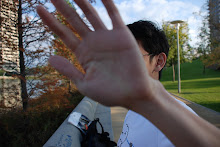Of Oxymorons.
Yes, indeed. Once again, it is time to delve deep(-er than we should) into the mysteries of mother nature, pull out a strange creature, and toss it under a microscope to be examined against its will, often probed and poked 'till the verge of death (which does not come, much to the creature's dismay and disappointment). Yes, it is that time again.
This time around, we have brought in an oxymoron. "Oxymoron" being its scientific name, it is often refered to as "doormat", due to this terms simpler nature and somewhat accuracy. Contrary to popular belief, "oxy" in "oxymoron" in no way means that it bears any physical resemblance to an ox. In fact, oxymorons are often mistaken for balls of wool, messy blotches of ink, modern art, and such. Mental capabilities aside, they are quite different from oxen. "Oxy" instead refers to what they feed on: Oxygen. Oxymorons feed only on pure oxygen and dust particles in the air, which is lucky for them, seeing as they don't have eyes to look for food with. Physically, an oxymoron is about the size of a large hamster and is covered in a layer of thick, often tri-colored fur, as shown in Figure 1.

Figure 1
"Moron", on the other hand, refers to its intelligence, or rather, lack thereof. Indeed, due to their tremendous lack of mental and visual faculties, these creatures frequently end up killing themselves by running head-long into predators or more often, off cliffs. As a result, enterprising businessmen often gather by the safer of the two (namely, the cliffs), and gather oxymoron carcasses by the truckload. They then send them off to their respective factories and/or sweatshops to be mass-produced into rugs. Afterwards, said rugs are quickly delivered to tourist markets, where there is a roaring trade of pointless, decorative furniture.
To summarize this documentary, I present you with Figure 2: A diagram displaying the life-cycle of an average oxymoron.

Figure 2
Until next time, toodles.


No comments:
Post a Comment